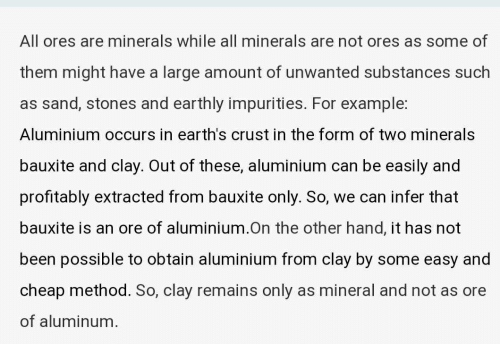Class 10 Exam > Class 10 Questions > Why all the ores are minerals but all the min...
Start Learning for Free
Why all the ores are minerals but all the mineral are not ores ?
Most Upvoted Answer
Why all the ores are minerals but all the mineral are not ores ?

Community Answer
Why all the ores are minerals but all the mineral are not ores ?
Explanation: Ores and Minerals
What are Minerals?
Minerals are naturally occurring inorganic substances with definite chemical compositions and physical properties. They are formed by various geological processes and are found in various forms such as crystals, rocks, and ores. Examples include quartz, feldspar, mica, and calcite.
What are Ores?
Ores are minerals from which metals or other valuable minerals can be extracted profitably. They are deposits of minerals that are economically feasible to mine. Examples include iron ore, copper ore, and gold ore.
Why all the ores are minerals but all the minerals are not ores?
The reason why all ores are minerals but not all minerals are ores is that ores are minerals that have economic value and can be extracted profitably. On the other hand, minerals that do not have economic value or are too expensive to extract are not considered ores.
For example, quartz is a mineral that is widely distributed in the earth's crust and has many industrial uses. However, it is not an ore because it does not contain any valuable metals or minerals that can be extracted profitably.
Similarly, feldspar is a common mineral that is used in the production of ceramics, glass, and enamel. However, it is not an ore because it does not contain any valuable metals or minerals that can be extracted profitably.
Therefore, all ores are minerals, but not all minerals are ores.
Attention Class 10 Students!
To make sure you are not studying endlessly, EduRev has designed Class 10 study material, with Structured Courses, Videos, & Test Series. Plus get personalized analysis, doubt solving and improvement plans to achieve a great score in Class 10.

|
Explore Courses for Class 10 exam
|

|
Similar Class 10 Doubts
Why all the ores are minerals but all the mineral are not ores ?
Question Description
Why all the ores are minerals but all the mineral are not ores ? for Class 10 2024 is part of Class 10 preparation. The Question and answers have been prepared according to the Class 10 exam syllabus. Information about Why all the ores are minerals but all the mineral are not ores ? covers all topics & solutions for Class 10 2024 Exam. Find important definitions, questions, meanings, examples, exercises and tests below for Why all the ores are minerals but all the mineral are not ores ?.
Why all the ores are minerals but all the mineral are not ores ? for Class 10 2024 is part of Class 10 preparation. The Question and answers have been prepared according to the Class 10 exam syllabus. Information about Why all the ores are minerals but all the mineral are not ores ? covers all topics & solutions for Class 10 2024 Exam. Find important definitions, questions, meanings, examples, exercises and tests below for Why all the ores are minerals but all the mineral are not ores ?.
Solutions for Why all the ores are minerals but all the mineral are not ores ? in English & in Hindi are available as part of our courses for Class 10.
Download more important topics, notes, lectures and mock test series for Class 10 Exam by signing up for free.
Here you can find the meaning of Why all the ores are minerals but all the mineral are not ores ? defined & explained in the simplest way possible. Besides giving the explanation of
Why all the ores are minerals but all the mineral are not ores ?, a detailed solution for Why all the ores are minerals but all the mineral are not ores ? has been provided alongside types of Why all the ores are minerals but all the mineral are not ores ? theory, EduRev gives you an
ample number of questions to practice Why all the ores are minerals but all the mineral are not ores ? tests, examples and also practice Class 10 tests.

|
Explore Courses for Class 10 exam
|

|
Suggested Free Tests
Signup for Free!
Signup to see your scores go up within 7 days! Learn & Practice with 1000+ FREE Notes, Videos & Tests.

























